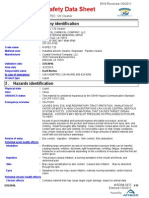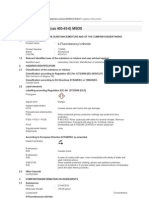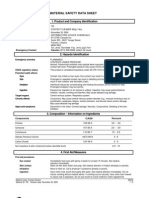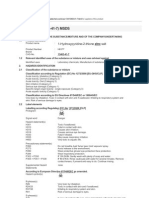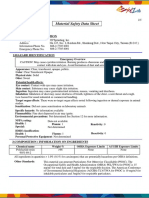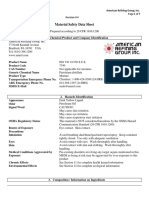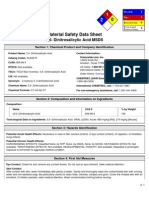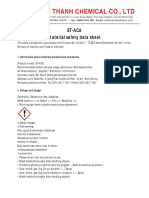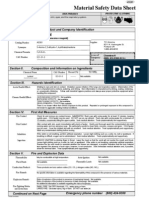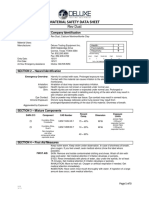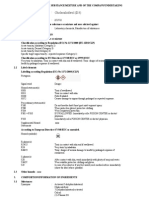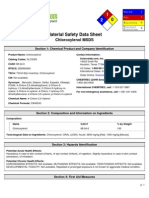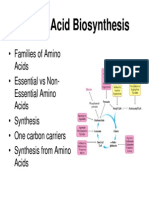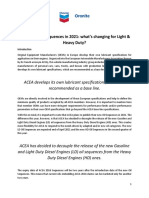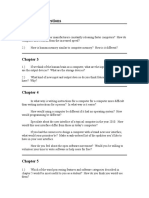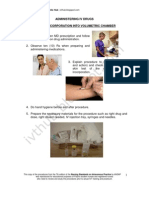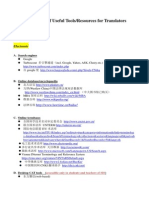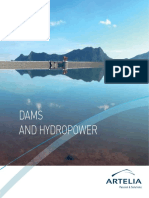Safety Data Sheet Ether, Anhydrous: Section 1 Product Description
Safety Data Sheet Ether, Anhydrous: Section 1 Product Description
Uploaded by
Silvi TatianCopyright:
Available Formats
Safety Data Sheet Ether, Anhydrous: Section 1 Product Description
Safety Data Sheet Ether, Anhydrous: Section 1 Product Description
Uploaded by
Silvi TatianOriginal Description:
Original Title
Copyright
Available Formats
Share this document
Did you find this document useful?
Is this content inappropriate?
Copyright:
Available Formats
Safety Data Sheet Ether, Anhydrous: Section 1 Product Description
Safety Data Sheet Ether, Anhydrous: Section 1 Product Description
Uploaded by
Silvi TatianCopyright:
Available Formats
Safety Data Sheet
Ether, Anhydrous
Section 1
Product Name:
Recommended Use:
Synonyms:
Distributor:
Chemical Information:
Chemtrec:
Product Description
Ether, Anhydrous
Science education applications
Ethyl Oxide, Ethyl Ether, Diethyl Ether
Carolina Biological Supply Company
2700 York Road, Burlington, NC 27215
1-800-227-1150
800-227-1150 (8am-5pm (ET) M-F)
800-424-9300 (Transportation Spill Response 24 hours)
Section 2
Hazard Identification
Classification of the chemical in accordance with paragraph (d) of 1910.1200;
DANGER
Extremely flammable liquid and vapor. Harmful if swallowed. Causes serious eye irritation. May cause drowsiness or dizziness.
GHS Classification:
Flammable Liquid Category 1, Serious Eye Damage/Eye Irritation Category 2A, Specific Target Organ Systemic Toxicity (STOT) Single Exposure Category 3, Acute Toxicity - Oral Category 4
Section 3
Chemical Name
Diethyl Ether, Anhydrous
Section 4
Composition / Information on Ingredients
CAS #
60-29-7
%
100
First Aid Measures
Emergency and First Aid Procedures
Inhalation:
IF INHALED: Remove victim to fresh air and keep at rest in a position comfortable for breathing.
Eyes:
IF IN EYES: Rinse cautiously with water for several minutes. Remove contact lenses, if present and easy
to do. Continue rinsing. If eye irritation persists: Get medical advice/attention.
Skin Contact:
IF ON SKIN (or hair): Remove/Take off immediately all contaminated clothing. Rinse skin with
water/shower.
Ingestion:
IF SWALLOWED: Call a POISON CENTER or doctor/physician if you feel unwell.
Section 5
Extinguishing Media:
Fire Fighting Methods and Protection:
Fire and/or Explosion Hazards:
Hazardous Combustion Products:
Section 6
Ether, Anhydrous
Firefighting Procedures
Use alcohol resistant foam, carbon dioxide, dry chemical, or water spray when fighting
fires. Water or foam may cause frothing if liquid is burning but it still may be a useful
extinguishing agent if carefully applied to the fire. Do not direct a water stream directly
into the hot burning liquid.
Firefighters should wear full protective equipment and NIOSH approved self-contained
breathing apparatus.
Above flashpoint, explosive vapor-air mixtures may be formed.
Carbon dioxide, Carbon monoxide
Spill or Leak Procedures
Page 1 of 4
Safety Data Sheet
Steps to Take in Case Material Is
Released or Spilled:
Exposure to the spilled material may be irritating or harmful. Follow personal protective
equipment recommendations found in Section 8 of this SDS. Additional precautions may be
necessary based on special circumstances created by the spill including; the material spilled,
the quantity of the spill, the area in which the spill occurred. Also consider the expertise of
employees in the area responding to the spill. Ventilate the contaminated area. Evaporation
of volatile substances can lead to the displacement of air creating an environment that can
cause asphyxiation. Persons not wearing appropriate protective equipment should be
excluded from area of spill until clean-up has been completed. Evacuate the area promptly.
Avoid breathing dust/fume/gas/mist/vapors/spray.
Prevent the spread of any spill to minimize harm to human health and the environment if safe
to do so. Wear complete and proper personal protective equipment following the
recommendation of Section 8 at a minimum. Dike with suitable absorbent material like
granulated clay. Gather and store in a sealed container pending a waste disposal evaluation.
Ventilate the area by opening door and/or turning on fans and blowers. Shut off ignition
sources; including electrical equipment and flames. Do not allow smoking in the area.
Contain spilled liquid with sand or earth. DO NOT use combustible materials such as
sawdust. Use appropriate personal protective equipment as stated in Section 8 of this MSDS.
Advise the Environmental Protection Agency (EPA) and appropriate state agencies, if
required. Absorb spill with inert material (e.g., dry sand or earth), then place in a chemical
waste container. Vacuum or sweep up material and place in a disposal container.
Section 7
Handling:
Storage:
Storage Code:
Handling and Storage
Keep away from heat/sparks/open flames/hot surfaces. No smoking. Keep container tightly closed.
Ground/bond container and receiving equipment. Use explosion-proof electrical/ventilating/lighting//
equipment. Use only non-sparking tools. Take precautionary measures against static discharge. Avoid breathing
dust/fume/gas/mist/vapors/spray. Wash thoroughly after handling. Do no eat, drink or smoke when using this
product. Use only outdoors or in a well-ventilated area. Wear protective gloves/protective clothing/eye
protection/face protection. Keep container tightly closed in a cool, well-ventilated place. Keep in a cool, wellventilated place away from ... (incompatible materials to be indicated by the manufacturer).
Keep container tightly closed. Store in a well-ventilated place. Keep container tightly closed. Store in a wellventilated place. Keep cool. Store locked up. Keep container tightly closed in a cool, well-ventilated place.
Red - Flammables. Store in approved flammable containers. Store away from oxidizing materials.
Section 8
Protection Information
ACGIH
Chemical Name
Diethyl Ether, Anhydrous
Control Parameters
Engineering Measures:
Personal Protective Equipment (PPE):
Respiratory Protection:
Respirator Type(s):
Eye Protection:
Skin Protection:
Gloves:
Section 9
Formula: C2H5OC2H5
Ether, Anhydrous
(TWA)
400 ppm TWA
(STEL)
500 ppm STEL
OSHA PEL
(TWA)
(STEL)
400 ppm TWA;
N/A
1200 mg/m3 TWA
Local exhaust ventilation or other engineering controls are normally required when
handling or using this product to avoid overexposure. Use process enclosures, local
exhaust ventilation, or other engineering controls to control airborne levels below
recommended exposure limits
Lab coat, apron, eye wash, safety shower.
No respiratory protection required under normal conditions of use. Wear a NIOSH
approved respirator if levels above the exposure limits are possible.
NIOSH approved air purifying respirator with organic vapor cartridge and dust/mist filter.
Wear chemical splash goggles when handling this product. Have an eye wash station
available.
Avoid skin contact by wearing chemically resistant gloves, an apron and other protective
equipment depending upon conditions of use. Inspect gloves for chemical break-through
and replace at regular intervals. Clean protective equipment regularly. Wash hands and
other exposed areas with mild soap and water before eating, drinking, and when leaving
work. Wash hands and other exposed areas with mild soap and water before eating,
drinking, and when leaving work. Where use can result in skin contact, practice good
personal hygiene. Use impervious gloves. Inspect gloves for chemical break-through and
replace at regular intervals. Clean protective equipment regularly.
Impervious rubber
Physical Data
Vapor Pressure: 587 hPa at 20C
Page 2 of 4
Safety Data Sheet
Molecular Weight: 74.12
Appearance: Colorless Liquid
Odor: No data available Characteristic
Odor Threshold: No data available
pH: No data available
Melting Point: 116 C
Boiling Point: 35 C
Flash Point: 45 C
Flammable Limits in Air: LEL: 1.9% UEL: 36.0%
Evaporation Rate (BuAc=1): 37.5
Vapor Density (Air=1): 2.55
Specific Gravity: 0.71
Solubility in Water: Soluble
Log Pow (calculated): 0.82 at 23 C
Autoignition Temperature: No data available 160 C
Decomposition Temperature: No data available
Viscosity: No data available
Percent Volatile by Volume: 100%
Section 10
Reactivity Data
Reactivity:
Chemical Stability:
Conditions to Avoid:
Hazardous Polymerization:
Section 11
Routes of Entry
Symptoms (Acute):
Delayed Effects:
No data available
Stable under normal conditions.
Sparks, open flame, other ignition sources, and elevated temperatures. Contact with air.
Will not occur
Toxicity Data
Inhalation and ingestion.
, Eye disorders, Liver disorders, Impaired Kidney Function, Respiratory disorders
No data available
Acute Toxicity:
Chemical Name
Diethyl Ether, Anhydrous
CAS Number
60-29-7
Oral LD50
Oral LD50 Rat
1215 mg/kg
Oral LD50 Mouse
1760 mg/kg
Dermal LD50
Dermal LD50
Rabbit > 20 ml/kg
Inhalation LC50
INHALATION
LC50 Mouse
31000 ppm
Carcinogenicity:
Chemical Name
No data available
CAS Number
60-29-7
IARC
Not listed
NTP
Not listed
OSHA
Not listed
Chronic Effects:
Mutagenicity:
Teratogenicity:
Sensitization:
Reproductive:
Target Organ Effects:
Acute:
Chronic:
No evidence of a mutagenic effect.
No evidence of a teratogenic effect (birth defect).
No evidence of a sensitization effect.
No evidence of negative reproductive effects.
See Section 2
Tumorigenic data cited., Mutation data cited., Not listed as a carcinogen by IARC, NTP or OSHA.
Section 12
Overview:
Mobility:
Persistence:
Bioaccumulation:
Degradability:
Other Adverse Effects:
Chemical Name
Diethyl Ether, Anhydrous
Section 13
Disposal Methods:
Waste Disposal Code(s):
Section 14
Ether, Anhydrous
Ecological Data
This material is not expected to be harmful to the ecology.
No data
No data
No data
No data
No data
CAS Number
60-29-7
Eco Toxicity
96 HR LC50 LEPOMIS MACROCHIRUS > 10000 MG/L [STATIC]
24 HR EC50 DAPHNIA MAGNA 165 MG/L
Disposal Information
Dispose in accordance with all applicable Federal, State and Local regulations. Always
contact a permitted waste disposer (TSD) to assure compliance.
Not Determined
Transport Information
Page 3 of 4
Safety Data Sheet
Ground - DOT Proper Shipping Name:
Air - IATA Proper Shipping Name:
UN number: 1155 Class: 3 Packing group: I Proper shipping name: UN number: 1155 Class: 3 Packing group: I Proper shipping
Diethyl ether Reportable Quantity (RQ): 100 lbs Marine pollutant:
name: Diethyl ether
No Poison Inhalation Hazard: No
Section 15
TSCA Status:
Regulatory Information
All components in this product are on the TSCA Inventory.
Chemical Name
CAS
Number
313 Name
304 RQ
CERCLA RQ
302 TPQ
CAA 112(2)
TQ
Diethyl Ether, Anhydrous
60-29-7
No
No
100 lb final RQ;
45.4 kg final
RQ
No
No
Section 16
Revised: 09/09/2015
Additional Information
Replaces: 09/03/2014
Printed: 10-29-2015
The information provided in this (Material) Safety Data Sheet represents a compilation of data drawn directly from various sources
available to us. Carolina Biological Supply makes no representation or guarantee as to the suitability of this information to a particular
application of the substance covered in the (Material) Safety Data Sheet.
Glossary
ACGIH
CAS
CERCLA
DOT
IARC
N/A
American Conference of Governmental
Industrial Hygienists
Chemical Abstract Service Number
Comprehensive Environmental Response,
Compensation, and Liability Act
U.S. Department of Transportation
International Agency for Research on Cancer
Not Available
Ether, Anhydrous
NTP
OSHA
PEL
ppm
RCRA
SARA
TLV
TSCA
IDLH
National Toxicology Program
Occupational Safety and Health Administration
Permissible Exposure Limit
Parts per million
Resource Conservation and Recovery Act
Superfund Amendments and Reauthorization Act
Threshold Limit Value
Toxic Substances Control Act
Immediately dangerous to life and health
Page 4 of 4
You might also like
- The Health & Safety Guide for Film, TV & Theater, Second EditionFrom EverandThe Health & Safety Guide for Film, TV & Theater, Second EditionRating: 4 out of 5 stars4/5 (1)
- N Spec 120 Cleaner Data SheetDocument11 pagesN Spec 120 Cleaner Data SheetSergio Alejandro Loza EscobarNo ratings yet
- Sodium Bromide SolutionDocument4 pagesSodium Bromide SolutionHunter HauswirthNo ratings yet
- HidrokarbonDocument2 pagesHidrokarbonSilvi TatianNo ratings yet
- HidrokarbonDocument2 pagesHidrokarbonSilvi TatianNo ratings yet
- ISO Reference Definitions - Guide 2 - 2004 - RevDocument25 pagesISO Reference Definitions - Guide 2 - 2004 - RevErickNo ratings yet
- Pakistan Violence Versus StabilityDocument217 pagesPakistan Violence Versus StabilityAfPakWars100% (2)
- MSDS Sodium CarbonateDocument6 pagesMSDS Sodium CarbonateEndang SupriyatnaNo ratings yet
- XL 740htDocument6 pagesXL 740htramsi17No ratings yet
- MSDS Calcipotriol Monohydrate PDFDocument9 pagesMSDS Calcipotriol Monohydrate PDFMouna BoussettaNo ratings yet
- MSDS Sodium ChlorideDocument6 pagesMSDS Sodium ChlorideEndang SupriyatnaNo ratings yet
- All Purpose Thinner Sep11Document4 pagesAll Purpose Thinner Sep11Paul De ChaufepieNo ratings yet
- BHT MSDSDocument5 pagesBHT MSDSChanpreet SinghNo ratings yet
- Lockstop Primer Adhesive SDS-GreenstreakDocument11 pagesLockstop Primer Adhesive SDS-Greenstreakrobox514No ratings yet
- Ghs Calcium Glycerophosphate MsdsDocument6 pagesGhs Calcium Glycerophosphate MsdsSRI VYJAYANTHI QANo ratings yet
- Acetone CPDocument6 pagesAcetone CPJonesHutaurukNo ratings yet
- Actellic 50 EcDocument9 pagesActellic 50 Ecnadi1onlyNo ratings yet
- Safety Data Sheet: 34078 / 1,4-Butandiol Standard Page 1 of 5Document5 pagesSafety Data Sheet: 34078 / 1,4-Butandiol Standard Page 1 of 5Elham DrsNo ratings yet
- Material Safety Data Sheet: 1. Product and Company IdentificationDocument10 pagesMaterial Safety Data Sheet: 1. Product and Company IdentificationFarazNo ratings yet
- 4-Fluorobenzoyl Chloride (Cas 403-43-0) MSDSDocument5 pages4-Fluorobenzoyl Chloride (Cas 403-43-0) MSDSMiMi JoyNo ratings yet
- Safety Data Sheet: Xtex Pty. LTD ABN 40 121 722 236 3 Kiln Street Malaga, WA 6090 1300-00-9839 Phone 0437-272-490 MobileDocument5 pagesSafety Data Sheet: Xtex Pty. LTD ABN 40 121 722 236 3 Kiln Street Malaga, WA 6090 1300-00-9839 Phone 0437-272-490 Mobiledwalding9956No ratings yet
- Protease 300 MCU MSDS: Section 1: Chemical Product and Company IdentificationDocument5 pagesProtease 300 MCU MSDS: Section 1: Chemical Product and Company IdentificationTaniadssNo ratings yet
- Sigma-Aldrich: Material Safety Data SheetDocument8 pagesSigma-Aldrich: Material Safety Data SheetRebecaNascimentoNo ratings yet
- MSDSPJDocument6 pagesMSDSPJapi-263411629No ratings yet
- MSDS SPN 80 - PT Tritunggal ArthamakmurDocument8 pagesMSDS SPN 80 - PT Tritunggal ArthamakmurSeftia NurfaNo ratings yet
- Contact CleanerDocument5 pagesContact CleanerlovefiezNo ratings yet
- MATERIAL SAFETY DATA SHEET (Ethylenedinitrilo) Tetraacetic AcidDocument5 pagesMATERIAL SAFETY DATA SHEET (Ethylenedinitrilo) Tetraacetic AcidmisterpokeNo ratings yet
- Chalcone MSDS: Section 1: Chemical Product and Company IdentificationDocument5 pagesChalcone MSDS: Section 1: Chemical Product and Company IdentificationNaveed SajidNo ratings yet
- Zinc Pyrithione (Cas 13463-41-7) MSDS: 1-Hydroxypyridine-2-ThioneDocument6 pagesZinc Pyrithione (Cas 13463-41-7) MSDS: 1-Hydroxypyridine-2-ThioneMiMi JoyNo ratings yet
- Thiophene-2-Ethylamine (Cas 30433-91-1) MSDS: 2-ThiopheneethylamineDocument5 pagesThiophene-2-Ethylamine (Cas 30433-91-1) MSDS: 2-Thiopheneethylamine4edcqweNo ratings yet
- MSDS Cat 108-8611 GrasaDocument12 pagesMSDS Cat 108-8611 Grasanauta007No ratings yet
- Material Safety Data Sheet: (Acute and Chronic)Document4 pagesMaterial Safety Data Sheet: (Acute and Chronic)Muhammad Andhika AlfaridziNo ratings yet
- Pep Set Al5995 CatalystDocument11 pagesPep Set Al5995 CatalystfeelingzudoNo ratings yet
- Maleic Anhydride MSDS: Section 1: Chemical Product and Company IdentificationDocument6 pagesMaleic Anhydride MSDS: Section 1: Chemical Product and Company IdentificationFábio BrancoNo ratings yet
- ANNEXURE-5 Material Safety Data SheetDocument11 pagesANNEXURE-5 Material Safety Data SheetSuraj KumarNo ratings yet
- 49 0 PDFDocument4 pages49 0 PDFMiMi JoyNo ratings yet
- SDS - Jotamastic 87 - Comp. A - Marine - Protective - English (Us) - United StatesDocument8 pagesSDS - Jotamastic 87 - Comp. A - Marine - Protective - English (Us) - United Stateskhor_albertNo ratings yet
- 11018m Safety Data SheetDocument4 pages11018m Safety Data SheetFreakaNo ratings yet
- Msds PDFDocument6 pagesMsds PDFFahad Maqsood100% (1)
- Material Safety Data Sheet: Product Name: PLA ModelDocument5 pagesMaterial Safety Data Sheet: Product Name: PLA ModeljuanNo ratings yet
- BenzinDocument6 pagesBenzinmicaziv4786No ratings yet
- Acetophenone PDFDocument6 pagesAcetophenone PDFYuliana Ja'farNo ratings yet
- Acetophenon PDFDocument6 pagesAcetophenon PDFYuris Yurdiansah Munandar0% (1)
- Safety Data Sheet: 1. IdentificationDocument8 pagesSafety Data Sheet: 1. IdentificationbattaNo ratings yet
- 7340 Iso VG 32 150 Sus Oil H43 7340Document7 pages7340 Iso VG 32 150 Sus Oil H43 7340William Lopez AyalaNo ratings yet
- Hexane (Cas 110-54-3) MSDSDocument6 pagesHexane (Cas 110-54-3) MSDSrtrydgfNo ratings yet
- Amine SDS 2021 - 1332471032Document9 pagesAmine SDS 2021 - 1332471032kathygona1980No ratings yet
- Terephthalic Acid MSDS: Section 1: Chemical Product and Company IdentificationDocument5 pagesTerephthalic Acid MSDS: Section 1: Chemical Product and Company IdentificationAbhishek KumarNo ratings yet
- Msds DNSADocument5 pagesMsds DNSAfontianikaNo ratings yet
- San Ur Il TabletsDocument4 pagesSan Ur Il TabletsHRK65No ratings yet
- Mono Ethylene Glycol MEGDocument6 pagesMono Ethylene Glycol MEGtabriz.alizada.engNo ratings yet
- Msds St-Aca English 2023Document7 pagesMsds St-Aca English 2023danghoangtube002No ratings yet
- Msdssodium Bisulfite MsdsDocument6 pagesMsdssodium Bisulfite MsdsSuth SeNo ratings yet
- Safety Data Sheet: 1. IdentificationDocument7 pagesSafety Data Sheet: 1. IdentificationNitinPrachiJainNo ratings yet
- 2227 - LuminolDocument3 pages2227 - LuminolLucas BrasilianoNo ratings yet
- Rev-Dust R1Document3 pagesRev-Dust R1angel_113No ratings yet
- (+/-) - 10-Camphorsulfonic Acid MSDS: Section 1: Chemical Product and Company IdentificationDocument6 pages(+/-) - 10-Camphorsulfonic Acid MSDS: Section 1: Chemical Product and Company IdentificationPulbere NeagraNo ratings yet
- Benzene, 1-Bromo-2-Fluoro - (Cas 1072-85-1) MSDSDocument5 pagesBenzene, 1-Bromo-2-Fluoro - (Cas 1072-85-1) MSDSMiMi JoyNo ratings yet
- Cholecalciferol (D3)Document1 pageCholecalciferol (D3)Muhammad AkramNo ratings yet
- Di Ammonium Phosphate - ProchemDocument4 pagesDi Ammonium Phosphate - ProchemLie Lili LimantonoNo ratings yet
- MsdsDocument5 pagesMsdsbindas4uNo ratings yet
- 2013 01 Cumene Hydroperoxide Aldrich MSDSDocument7 pages2013 01 Cumene Hydroperoxide Aldrich MSDStpr314No ratings yet
- Georgia Pest Management Handbook: 2021 Home and Garden EditionFrom EverandGeorgia Pest Management Handbook: 2021 Home and Garden EditionEmily CabreraNo ratings yet
- Alkane Alkene Alkyne Reaction Worksheet PDFDocument2 pagesAlkane Alkene Alkyne Reaction Worksheet PDFSilvi TatianNo ratings yet
- 3 Organic Chemistry: Unit Test - PracticeDocument5 pages3 Organic Chemistry: Unit Test - PracticeSilvi TatianNo ratings yet
- PROBLEMS DaltonsLaw PDFDocument1 pagePROBLEMS DaltonsLaw PDFFact aazNo ratings yet
- Sukrosa PDFDocument5 pagesSukrosa PDFSilvi TatianNo ratings yet
- Ferric Ammonium Sulfate, 0.1 N MSDS: Section 1: Chemical Product and Company IdentificationDocument6 pagesFerric Ammonium Sulfate, 0.1 N MSDS: Section 1: Chemical Product and Company IdentificationSilvi TatianNo ratings yet
- Safety Data Sheet: 1. IdentificationDocument10 pagesSafety Data Sheet: 1. IdentificationSilvi TatianNo ratings yet
- 451amino Acid BiosynthesisDocument21 pages451amino Acid BiosynthesisSilvi TatianNo ratings yet
- Juno PDFDocument52 pagesJuno PDFSilvi TatianNo ratings yet
- Center of Rigidity - ETABS - CSIDocument2 pagesCenter of Rigidity - ETABS - CSIabdul khader100% (1)
- MonthlyTest LRDocument20 pagesMonthlyTest LRUyên HoàngNo ratings yet
- Certificate of WeightDocument3 pagesCertificate of WeightTrần HiềnNo ratings yet
- 2021.04 - Chevron Oronite - ACEA New Oil Sequences in 2021 (Final)Document8 pages2021.04 - Chevron Oronite - ACEA New Oil Sequences in 2021 (Final)maiatostiNo ratings yet
- News Kaki: Five Men in Serangoon Slashing Case Charged in CourtDocument2 pagesNews Kaki: Five Men in Serangoon Slashing Case Charged in CourtAnonymous 26hKWoEBwJNo ratings yet
- MRL W e Pack Electrical ManualDocument154 pagesMRL W e Pack Electrical ManualLe Huynh LongNo ratings yet
- Discussion QuestionsDocument9 pagesDiscussion QuestionsyourhunkieNo ratings yet
- Drug Incorporation Into Volumetric ChamberDocument3 pagesDrug Incorporation Into Volumetric ChamberNoel100% (4)
- CM 900sfullinstallguidev1 0Document32 pagesCM 900sfullinstallguidev1 0davidwithgreenwayrecyclersNo ratings yet
- A Collection of Useful Tools and Resources For TranslatorsDocument7 pagesA Collection of Useful Tools and Resources For Translatorsa88121599No ratings yet
- Fluent Inc. December 3, 2001Document10 pagesFluent Inc. December 3, 2001sxasxasxNo ratings yet
- 20 - Fire Protection System - FPSDocument3 pages20 - Fire Protection System - FPSGreen MichaelsNo ratings yet
- WT Coolant Supra - TDSDocument2 pagesWT Coolant Supra - TDSBudi SetiawanNo ratings yet
- Cover Note: Stamp Duty PaidDocument2 pagesCover Note: Stamp Duty PaidEncik NairulNo ratings yet
- List of Empanelled 2022 23Document26 pagesList of Empanelled 2022 23Alok Singh DangiNo ratings yet
- TaxonomyDocument9 pagesTaxonomyMauricio KlasserNo ratings yet
- Python Programming Guide BookDocument323 pagesPython Programming Guide Bookhashmisahib48100% (14)
- ARTELIA EE Dams and Hydropower BookDocument52 pagesARTELIA EE Dams and Hydropower BookAnonymous HhxvQ537xNo ratings yet
- ATV31 - ModbusDocument17 pagesATV31 - ModbusCesar HerreraNo ratings yet
- Nozzle Design Paper PDFDocument55 pagesNozzle Design Paper PDFjai_selva100% (3)
- Managing Fire Risk in Commercial BuildingsDocument8 pagesManaging Fire Risk in Commercial BuildingsSophie-Louise MercedesNo ratings yet
- Shell Script KanetkarDocument12 pagesShell Script KanetkarBhushan BhuptaNo ratings yet
- Final Project Report Fitness AppDocument56 pagesFinal Project Report Fitness Appshakthiraj400No ratings yet
- Philippine Savings Bank Group 7Document75 pagesPhilippine Savings Bank Group 7Desmond WilliamsNo ratings yet
- Plumbing Appurtenance Compiled by Kats MendozaDocument85 pagesPlumbing Appurtenance Compiled by Kats MendozaKatsMendozaNo ratings yet
- ETKIN Medical DevicesDocument11 pagesETKIN Medical DevicesFIRAS HAMIDNo ratings yet
- U2 Working & AuxiliaryDocument48 pagesU2 Working & AuxiliaryNurye Nigus100% (1)
- AssignmentDocument21 pagesAssignmentrashantNo ratings yet

